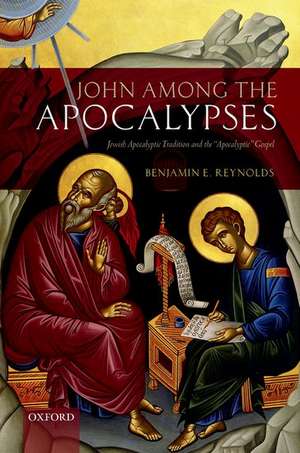John among the Apocalypses: Jewish Apocalyptic Tradition and the 'Apocalyptic' Gospel
Autor Benjamin E. Reynoldsen Limba Engleză Hardback – 22 oct 2020
Preț: 582.93 lei
Preț vechi: 698.69 lei
-17% Nou
Puncte Express: 874
Preț estimativ în valută:
111.58€ • 121.24$ • 93.79£
111.58€ • 121.24$ • 93.79£
Carte disponibilă
Livrare economică 20-26 martie
Preluare comenzi: 021 569.72.76
Specificații
ISBN-13: 9780198784241
ISBN-10: 0198784244
Pagini: 272
Dimensiuni: 165 x 245 x 20 mm
Greutate: 0.64 kg
Editura: OUP OXFORD
Colecția OUP Oxford
Locul publicării:Oxford, United Kingdom
ISBN-10: 0198784244
Pagini: 272
Dimensiuni: 165 x 245 x 20 mm
Greutate: 0.64 kg
Editura: OUP OXFORD
Colecția OUP Oxford
Locul publicării:Oxford, United Kingdom
Recenzii
Reynolds defines broadly, the Johannine Jesus descends from heaven and speaks about heavenly things. The book's chapters focus on genre theory, then the manner, the content, and the function of revelation in John and the apocalypses, as well as John's generic classification, its view of Moses, and its relationship with the book of Revelation.
Reynolds's detailed engagement with both primary and secondary sources, including comments on John's possible social setting, makes the volume a helpful addition to discussions of how and why the Gospel reveals its message and messenger.
Reynolds's detailed engagement with both primary and secondary sources, including comments on John's possible social setting, makes the volume a helpful addition to discussions of how and why the Gospel reveals its message and messenger.
Notă biografică
Benjamin E. Reynolds is Professor of New Testament at Tyndale University in Toronto. He is author of The Apocalyptic Son of Man in the Gospel of John (Mohr Siebeck, 2008), editor of The Son of Man Problem (T&T Clark, 2018), co-editor with Loren Stuckenbruck of The Jewish Apocalyptic Tradition and the Shaping of New Testament Thought (Fortress, 2017), and co-editor with Gabriele Boccaccini of Reading the Gospel of John's Christology as Jewish Messianism: Royal, Prophetic, and Divine Messiahs (Brill, 2018).
